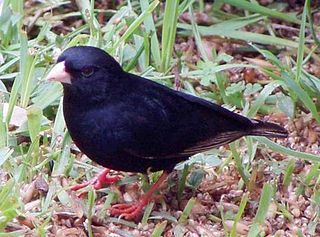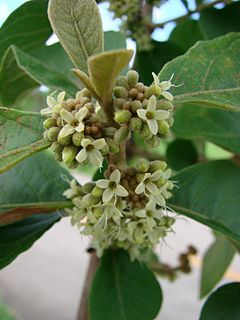
The crested guan is a member of an ancient group of birds of the family Cracidae, which are related to the Australasian megapodes or mound builders (Megapodiidae). It is found in the Neotropics, in lowlands forests ranging from south Mexico and the Yucatán Peninsula to western Ecuador and southern Venezuela. The sexes are similar in appearance; the plumage is mainly dark brown with white spotting, an area of bare skin round the eye, bright red wattles, a bushy crest, a long broad tail and pink legs. It is a social bird, often seen in pairs or small family groups. It feeds in trees, mainly on fruit, and builds a nest of twigs on a branch. The two or three white eggs are incubated by the female. The International Union for Conservation of Nature has rated this bird's conservation status as "least concern".

Ptisana purpurascens is a large fern belonging to the botanical family Marattiaceae. It has a globular rhizome with stipule-like fleshy outgrowths. The leaves are dark green, twice pinnate and up to 1 metre long. Every pinnule has up to six pairs of leaflets. The petioles are dark-purplish, hence the name 'purpurascens' meaning 'becoming purple'. The sporangia are fused in all Ptisana into a bivalvate synangium.

Aegiphila lhotskiana is a species of flowering plant in the family Lamiaceae. It is native to South America, where it occurs in Bolivia and Brazil. This species is cited in Flora Brasiliensis by Carl Friedrich Philipp von Martius.

Dalbergia purpurascens is a species of legume in the family Fabaceae.

The dusky indigobird, variable indigobird, or black widowfinch is a species of bird in the family Viduidae. It is found in Angola, Burundi, Cameroon, Republic of the Congo, Democratic Republic of the Congo, Guinea-Bissau, Malawi, Mozambique, Nigeria, Sierra Leone, South Africa, Swaziland, Tanzania, Zambia, and Zimbabwe. Its natural habitat is moist savanna.

The purple indigobird is a species of bird in the family Viduidae. It is also known as the dusky indigobird, a name which can refer to Vidua funerea. It is found in Angola, Botswana, Democratic Republic of the Congo, Kenya, Malawi, Mozambique, South Africa, Tanzania, Zambia, and Zimbabwe. Its natural habitat is dry savanna.
Aegiphila cordifolia is a species of flowering plant in the family Lamiaceae. It is endemic to Peru, where it occurs in the Amazon rainforest. It is sometimes found in disturbed habitat.

Aegiphila is a genus of flowering plants in the mint family, Lamiaceae, first described in 1763. It was formerly classified in the Verbenaceae. It is native to Mexico, Central America, South America, the West Indies, and Florida.
Aegiphila fasciculata is a species of tree in the family Lamiaceae. It is native to Central America, where it occurs in Guatemala, Honduras, and Nicaragua. It grows in humid forest habitat.

Aegiphila ferruginea is a species of flowering plant in the family Lamiaceae. It is endemic to Ecuador. It occurs in the high Andes between 2000 and 4000 meters in elevation, where it grows in cloud forest. There are about 15 wild populations known. It is a shrub or tree that grows easily in disturbed habitat and it can be a common roadside plant in some areas. It is also cultivated on a small scale.
Aegiphila glomerata is a species of flowering plant in the family Lamiaceae. It is endemic to Ecuador, where it has been found at only three locations. It occurs in low-elevation coastal dry forests.
Aegiphila monticola is a species of tree in the family Lamiaceae. It is endemic to Ecuador, where it is known from Cotopaxi and Bolívar Provinces. There are about eight populations.
Aegiphila panamensis is a species of flowering plant in the family Lamiaceae. It is native to the Americas, its distribution extending from Mexico to Colombia.
Aegiphila rimbachii is a species of tree in the family Lamiaceae. It is endemic to Bolívar Province in Ecuador, where it grows in the cloud forests of the Andes.
Aegiphila schimpffii is a species of tree in the family Lamiaceae. It is endemic to Ecuador, where it is known from five populations. It occurs in coastal forest habitat and foothills up to 1000 meters in elevation.
Aegiphila skutchii is a species of flowering plant in the family Lamiaceae. It is native to Guatemala, Honduras, and Mexico.
Aegiphila sordida is a species of flowering plant in the family Lamiaceae. It is endemic to Peru.
Hedyosmum purpurascens is a species of plant in the Chloranthaceae family. It is endemic to Ecuador. Its natural habitat is subtropical or tropical moist montane forests.
Aegiphila monstrosa is a species of flowering plant in the family Lamiaceae. It is found in Belize, Guatemala, Honduras, and Mexico. It is threatened by loss of habitat to agriculture.

The brown kukri snake is a species of snake of the family Colubridae.









